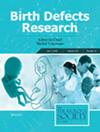Although many factors are associated with gastroschisis risk, studies have not systematically explored whether they account for its increasing frequency over the past decades or its inverse association with maternal age. We examined whether previously reported risk factors for gastroschisis from the National Birth Defects Prevention Study (NBDPS) explain the association with increasing temporal prevalence or young maternal age.
Using data from the NBDPS (1997–2011), crude odds ratios (ORs) were calculated for birth years 2005–2011 versus 1997–2004 and maternal age < 25 versus 25+ years. We then adjusted for 16 factors separately with logistic regression (paternal age, interpregnancy interval, parity, alcohol, cigarettes, illicit drugs, oral contraceptives, cold/flu with fever, genitourinary infection, polycyclic aromatic hydrocarbons, diet quality, prepregnancy body mass index, parental race and ethnicity, language spoken at home, years lived in the United States, and household income).
The birth year OR (1.28; 95% CI: 1.14, 1.44) was attenuated by 16% after adjustment for polycyclic aromatic hydrocarbon exposure (OR 1.08; 95 CI: 0.92, 1.26). The young maternal age OR (7.76; 95% CI: 6.71, 8.97) was attenuated by 30% after adjustment for paternal age (OR 5.43; 95% CI: 4.55, 6.48) and separately for interpregnancy interval (OR 5.45; 95% CI: 4.43, 6.69).
Some evidence suggests that risk factors for gastroschisis account for small amounts of the time trend and maternal age associations. However, it remains unclear what factors underlie the complete calendar time or maternal age associations.


